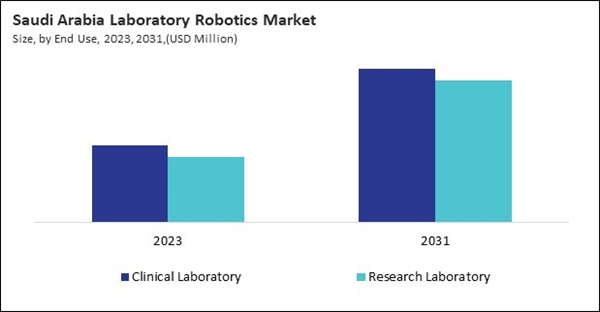The Brazil market dominated the LAMEA Laboratory Robotics Market by Country in 2023, and is forecast to continue being a dominant market till 2031; thereby, achieving a market value of $44.6 million by 2031. The Argentina market is registering a CAGR of 9.3% during (2024 - 2031). Additionally, The UAE market would showcase a CAGR of 7.7% during (2024 - 2031).
One of the primary reasons for adopting laboratory robotics is their capacity to execute tasks with exceptional precision and accuracy. Automated systems reduce human error, variability, and contamination risks in sample handling, measurement, and experimental workflows. This is crucial in drug discovery, genomics, and clinical diagnostics, where precise results are paramount for research validity and patient care.
Laboratory robotics significantly enhance throughput by automating repetitive and time-consuming tasks that would otherwise require extensive manual labour. Automated liquid handling, sample preparation, and assay processing accelerate experimental timelines and increase the sample volume per unit time. This scalability is particularly beneficial in high-throughput screening, biobanking, and industrial quality control applications.
The Saudi government’s Vision 2030 initiative aims to diversify the economy, with healthcare and pharmaceuticals being key sectors. Increased government investment and support for the pharmaceutical industry can spur demand for advanced laboratory robotics to enhance research capabilities and pharmaceutical production efficiency. According to the National Library of Medicine, Saudi Arabia’s pharmaceutical drugs industry is expected to grow by 7.3% during the forecast period (2020-2027), owing to the increasing number of drug launches and approvals. As part of Vision 2030, there’s an emphasis on localizing industries and reducing import dependency. This could lead to partnerships between international robotics manufacturers and local companies to establish production facilities or technology transfer initiatives for laboratory robotics within Saudi Arabia.
The Saudi pharmaceutical industry is increasingly embracing digital transformation to improve operational efficiency and meet global standards. Laboratory robotics play a crucial role in this transformation by automating processes, reducing errors, and enhancing data accuracy and traceability in drug development and testing. Hence, increasing healthcare sector investment and the rising pharmaceutical industry drive the market's growth.
List of Key Companies Profiled
- Peak Analysis and Automation Ltd (PAA)
- PerkinElmer, Inc.
- Thermo Fisher Scientific Inc.
- Hudson Robotics, Inc.
- Anton Paar GmbH
- Danaher Corporation (Beckman Coulter, Inc.)
- Siemens Healthineers AG (Siemens AG)
- AB Controls, Inc.
- Abbott Laboratories
Market Report Segmentation
By End Use- Clinical Laboratory
- Research Laboratory
- Drug Discovery
- Genomics Solutions
- Clinical Diagnosis
- Proteomics Solutions
- Microbiology Solutions
- Lab Automation Workstations
- Automated Plate Handlers
- Automated Liquid Handling Robots
- Robotic Arms
- Microplate Readers and Washers
- Others
- Brazil
- Argentina
- UAE
- Saudi Arabia
- South Africa
- Nigeria
- Rest of LAMEA
Table of Contents
Companies Mentioned
- Peak Analysis and Automation Ltd (PAA)
- PerkinElmer, Inc.
- Thermo Fisher Scientific Inc.
- Hudson Robotics, Inc.
- Anton Paar GmbH
- Danaher Corporation (Beckman Coulter, Inc.)
- Siemens Healthineers AG (Siemens AG)
- AB Controls, Inc.
- Abbott Laboratories
- BIOMÉRIEUX
Methodology

LOADING...









